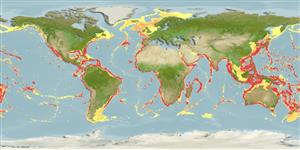Common names from other countries
Environment: milieu / climate zone / depth range / distribution range
Ekologi
Pelagis, permukaan; kisaran kedalaman 0 - 2000 m (Ref. 97142). Tropical
Circumglobal. Tropical to temperate climates.
Length at first maturity / Size / Weight / umur
Maturity: Lm ? range ? - ? cm Max length : 42.0 cm ML jantan/; (Ref. 97142)
The vertical distribution of paralarvae to approximately 35 mm mantle length is epipelagic, concentrated in subsurface water to 200 m both day and night. With growth and metamorphosis (around 35 to 40 mm mantle length) juveniles broaden their range in the mesopelagic zone to 800 m or more. One subadult female was captured in a closing net at night at 800 to 600 m in the western North Atlantic. Subadults and adults descend into the bathypelagic zone where maturation occurs in the 2,000 m zone. Captures of juveniles and large subadults at night in subsurface waters to about 300 m suggests that a portion of the population undergoes a diel vertical migration (Ref. 97142).
Life cycle and mating behavior
Kematangan | Reproduksi, perkembang biakan | Pemijahan | telur-telur | Fecundity | Larva
Members of the class Cephalopoda are gonochoric. Male and female adults usually die shortly after spawning and brooding, respectively. Mating behavior: Males perform various displays to attract potential females for copulation. During copulation, male grasp the female and inserts the hectocotylus into the female's mantle cavity where fertilization usually occurs. Life cycle: Embryos hatch into planktonic stage and live for some time before they grow larger and take up a benthic existence as adults.
rujukan utama
Acuan | Koordinator | mitra
Turgeon, D.D., J.F. Quinn Jr., A.E. Bogan, E.V. Coan, F.G. Hochberg, W.G. Lyons, P.M. Mikkelsen, R.J. Neves, C.F.E. Roper, G. Rosenberg, B. Roth, A. Scheltema, F.G. Thompson, M. Vecchione and J.D. Willams. 1998. (Ref. 1667)
Status IUCN Red List (Ref. 130435)
status CITES (Ref. 108899)
Not Evaluated
Not Evaluated
penggunaan manusia
| FishSource |
Alat, peralatan
informasi lanjut
Umur / SaizPertumbuhanpanjang-beratpanjang-panjangMorfologiLarvaKelimpahan
Sumber internet
Estimates based on models
Preferred temperature
(Ref.
115969): 5.2 - 14.5, mean 8.9 (based on 1809 cells).
